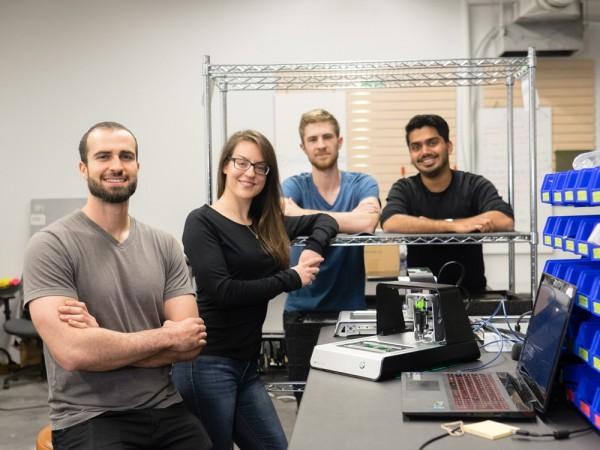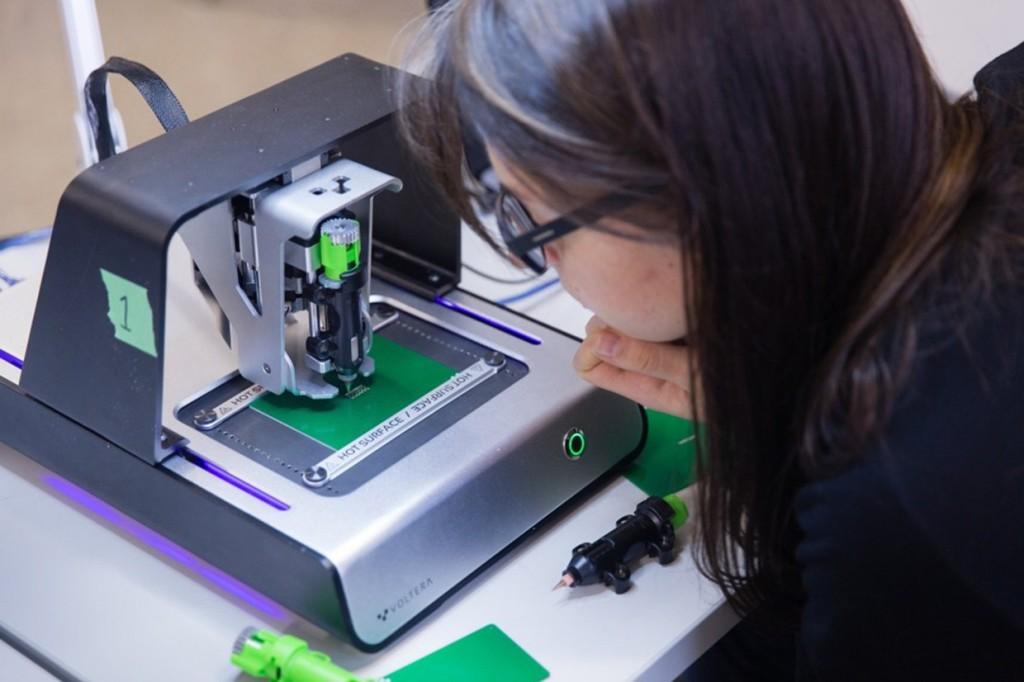Making PCBs–And Fast! University of Waterloo Grads Win Dyson Award for Voltera V-One, Inspired by 3D Printer
 It’s the future. It’s fast. And it’s all about power, quite literally. The Voltera V-One, created by a group of graduate students from the University of Waterloo, Canada shows the evolution of 3D printing–and the subsequent fabrication of electronics–quite succinctly.
It’s the future. It’s fast. And it’s all about power, quite literally. The Voltera V-One, created by a group of graduate students from the University of Waterloo, Canada shows the evolution of 3D printing–and the subsequent fabrication of electronics–quite succinctly.
At first it was like virtual magic, observing a digital file come to life, layer by layer. That was so exciting that makers everywhere wanted to see what else they could put into the fold with their models. What more can we make these 3D printed objects do? Can they become multifunctional? How can these models serve us better, and all in one? As innovations built upon one another rapidly, makers around the world discovered that indeed even further complexities could be added into the 3D printing process. And the magic has just continued to expand.
Being able to 3D print circuit boards is one thing, but being able to do it well is another. Searching to put all of the pieces together for producing a superior, fabricated PCB, the researchers examined the prototyping process in-depth and worked to create a machine meant specifically to make PCBs rather than just tacking them onto 3D printing, or producing minimally conductive items.
Traditionally, manufacturing circuit boards can be an arduous task when a need for modification arises. As most of us are keenly aware by now, the benefit in 3D printing is that the digital design process allows for extreme ease in making broad changes, slight tweaks, and then sending them back to the 3D printer conveniently–and independent of a middleman in most cases.
 Now, not only has this group of graduate students figured out how to fabricate PCBs, but they can do it rapidly, in a matter of just minutes. Very possibly holding the future of an industry in their hands, the team won the James Dyson Award, granting them $45,000. This comes on the heels of a Kickstarter campaign as well, for which the group received $502,310. We first covered the Voltera V-One back in February, just as the Kickstarter campaign was first launched.
Now, not only has this group of graduate students figured out how to fabricate PCBs, but they can do it rapidly, in a matter of just minutes. Very possibly holding the future of an industry in their hands, the team won the James Dyson Award, granting them $45,000. This comes on the heels of a Kickstarter campaign as well, for which the group received $502,310. We first covered the Voltera V-One back in February, just as the Kickstarter campaign was first launched.
“The Voltera V-One team is made up of four impressive young graduates,” James Dyson said. “Their solution makes prototyping electronics easier and more accessible – particularly to students and small businesses. But it also has the potential to inspire many more budding engineers — something I am very passionate about indeed.”
The founders of Voltera, with specialties in mechatronics and nanotechnology, are Alroy Almeida, Katarina Ilic, James Pickard, and Jesús Zozaya.
As small as a laptop computer, the Voltera V-One also mimics the size and design of a 3D printer, obviously working as significant inspiration, which is not surprising considering that electronics are integrated into so many 3D printed items today. Indeed, we follow numerous companies integrating electronics from 3D printed flashlights to more research and development projects like that of ink meant to aid in metal 3D printing with conductivity.“Our parts are now being manufactured and we are about to begin a new wave of testing in our lab,” said Zozaya in a statement. “The $45,000 we’ve been awarded as winners of the James Dyson Award will help us to ramp up production and enhance testing.”
 The Voltera V-One uses a variety of materials that are conductive, in the form of insulating inks responsible for the creation of two-layer circuit boards. Like the 3D printer, the boards are also created in a digitally streamlined manner, straight from the user’s files. The group has also created a solder paste dispenser within it, adding a multi-faceted element, allowing for additional components to be added to the board. It works via a heating element that allows the solder to be melted into new and conductive connections.
The Voltera V-One uses a variety of materials that are conductive, in the form of insulating inks responsible for the creation of two-layer circuit boards. Like the 3D printer, the boards are also created in a digitally streamlined manner, straight from the user’s files. The group has also created a solder paste dispenser within it, adding a multi-faceted element, allowing for additional components to be added to the board. It works via a heating element that allows the solder to be melted into new and conductive connections.
Runners up for this contest were quite formidable with a winner from Taiwan who created a system to help with water purification, as well as a student from the University of Limerick who created a diving system that is much more simplified for breathing underwater. Both will also receive cash prizes in the form of $7500.
Subscribe to Our Email Newsletter
Stay up-to-date on all the latest news from the 3D printing industry and receive information and offers from third party vendors.
You May Also Like
UpNano Launches 2PP 3D Printing Service with New NanoPro VT Printer
UpNano, an Austrian company specializing in two-photon polymerization (2PP) additive manufacturing (AM), has launched a service bureau that will offer high-volume output of microscale parts. The new service, NanoPro, will...
Materialise Updates Magics and Partners with BLT at Formnext 2024
At this year’s Formnext, 3D printing software and services pioneer Materialise, unveiled a series of software updates designed to enhance customization capabilities in 3D printing for its users. The announcement...
HP’s New Materials, Tools, and Collaborations to Drive 3D Printing Forward at Formnext 2024
At Formnext 2024, HP unveiled several key developments aimed at advancing additive manufacturing (AM), with new materials, workflow optimization tools, and expanded metal printing capabilities. These announcements reinforce HP’s strategy...
Farsoon at Formnext: What’s New in 3D Printing for 2024
With Formnext 2024 underway in Frankfurt, Farsoon Technologies (SHA: 688433) is showcasing a series of developments unveiled in the lead-up to the event. From advancing food-safe 3D printing for the...





































